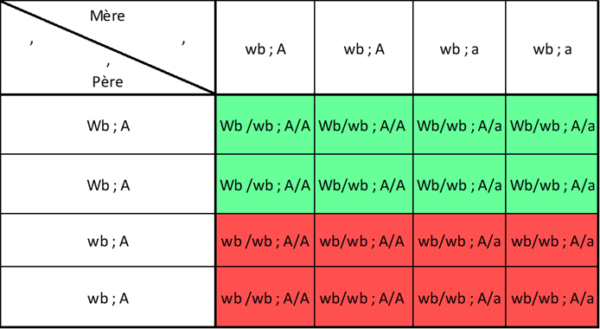This article aims to explain as clearly as possible the genetics of the shaded in the Maine Coon. The goal is to answer all the questions that I read or that I am asked: is my cat shaded, if I breed my cat will I have shaded kittens, is my cat a carrier of shaded, etc. …
The subject is not complex but you can often read nonsense on the internet that only accentuates the mystery around this dress. So I’m going to try to demystify that in this article. Let me introduce myself, I am Nicolas Harlé, Maine Coon breeder for several years at the Maine Coon Corp in Amiens, former professor of biology, holder of a master’s degree in biology, and former breeder of Oriental Siamese.
There will be several parts to this article: the first will explain the basics of genetics in general then its application to shaded Maine coons, the second will define what the shaded coat is as well as all the vocabulary that revolves around it and we will end with some concrete examples accompanied by what are called crossing chessboards.
Genetic
Before attacking shaded genetics, I will go over some basic notions of genetics with you. Genetics is the study of genes, genes are portions of DNA which, placed end to end, constitute the chromosomes, each gene will be at the origin of an apparent character (color, stripes, white…). A human being has 22,000 differents genes, there are genes that code for hair color, eye color, ear size, etc. Here we are going to focus on cat genes that code for shaded dresses. These genes are therefore found on very specific chromosomes at very specific locations called locii.
As a reminder, the human being has 23 pairs of chromosomes including 1 pair of sex chromosomes which determine the genetic sex of the individual, the cat has 38 pairs including 1 pair of sex chromosomes. So why am I telling you this… quite simply to explain to you that chromosomes work in pairs and therefore, inevitably, so do genes. Each gene is present in two copies and therefore in 2 versions, they can be identical, we then speak of homozygote or differ, we then speak of heterozygote. There is an exception: these are the sex chromosomes in the male, but we will not talk about it because the genes involved in the shaded are not carried by the sex chromosomes.
A gene can therefore exist in several forms, these are called alleles. These alleles can be either dominant (often written with a capital letter ex: Wb), recessive (often written with a lowercase letter ex: wb) or co-dominant. A dominant allele will prevent the expression of a recessive allele which will then be dormant for this generation, but may eventually be transmitted to offspring. Both codominant alleles will be expressed. For the shaded alleles are dominant and recessive, but I will come back to this.
Let’s take a concrete example: the gene responsible for human eye color. There is one allele for blue eyes which is recessive rated ‘a’ and one allele for brown eyes which is dominant rated ‘A’.
An individual a/a will have blue eyes he is said to be homozygous
An a/A individual will have brown eyes and is said to be heterozygous (the “a” is dormant on this generation but may eventually encounter another “a” in the offspring).
An A/A individual will have brown eyes it is said … homozygous
This explains that 2 brown-eyed people can have a blue-eyed child if both parents are heterozygous: A/a x A/a will give 25% of A/A, 50% of A/a and 25% of a/a
Let’s move on to shaded and its genetics
We are finally going to get to the heart of the matter, but before that, a little vocabulary so that we understand each other well afterwards. You have surely heard of shaded, chinchilla, shell… the shaded coat may or may not be accompanied by the silver gene. If the silver gene is expressed we speak of SILVER shaded, if it is not expressed we then speak of GOLDEN shaded. The CHINCHILLA is a silver shaded with low tipping (see below), the SHELL is a golden shaded with low tipping.
Tipping is a characteristic that consists of the restriction of dark pigmentation to a small part of the tip of each hair. We can see on the diagram below the different types of tipping.

The tipping of a shaded corresponds to a maximum of ¼ of the marked hair for 1/8th in chinchillas/shells. It is possible that silver cats have less tipping than a shaded one, we speak of high silver or pale what will make the difference in this case is that a high silver will show a real tabby marking. The gene that codes for the shaded is the Wb gene for WIDE band, this gene will cause the agouti marking band (TABBY) to disappear. This brings me to the most important notion of this article… the Wb (shaded) gene IS related to the A (agouti) gene.
The agouti gene noted A is a dominant gene at the origin of tabby markings. This means that the Wb gene will be expressed if and only if the cat has an A allele, i.e. its agouti genotype must be A/A (homozygous) or A/a (heterozygous) to be able to deploy her dress shaded.
If the cat is non-agouti, that is to say homozygous a/a, the shaded gene will not be expressed even if it is present, at best it will be a carrier of the Wb gene which can emerge in the event of reproduction with a partner with an A gene.
So you will understand that when you see a “shaded lineage” cat that does not mean that you can have shaded cats in breeding, and if ever the cat is tabby, then he cannot be a shaded carrier otherwise he would be shaded, even if it is high silver. So analyze the pedigree of the parents well to have the best possible chance that the cat is a carrier of the Wb gene.
I haven’t talked about silver yet. Often we see silver shaded cats. The silver gene which is dominant is not necessary to have a shaded cat, if it does not have the silver gene it will then be golden shaded, and if it has it it will be silver shaded…
How do I know if my cat is high silver or shaded silver?
There is often confusion between shaded silver cats and so-called high silver cats. High silver cats have a “powerful” version of the silver gene that causes tipping to be very low. What differentiates a high silver from a shaded is the tabby marking and not the intensity of the color. The Wb gene causes the tabby marking to disappear, but traces of it may remain, especially on the head and legs. The marking on the head must be very weak, the marking on the back almost non-existent, the rings on the legs must not be closed, the inside of the legs must be without marking. Ditto for the tail, the underside of the tail should also be unmarked.
The expression of the Wb gene evolves with the growth of the animal, often they are born with a white head and marked body, this will disappear during the first weeks of life.
For black silver shaded cats the nose should be black on the edges and pink in the center.
At the time of puberty and during the winter the hair tends to darken, but it lightens again in adulthood and with the onset of warmer days (yes when it’s cold cats tend to darken). So I advise you to wait before placing your kitten as high silver or shaded because this can change!
The crosses
This is the most technical part. How do I know if I will have shaded kittens with my cats? To do this, you have to make a crossing checkerboard, but above all you have to know if your breeding animals are homozygous or heterozygous for the Wb and A genes. Once you have that, you make a double-entry table. We will take the example of a male shaded Wb/wb; A/A and a female wb/wb tabby; A/a.
It is first necessary to determine which genes they will give to their descendants.

The male will be able to give Wb and A, or wb and A since at the time of fertilization he will only give 1 of his genes, the 2nd coming from the mother.
The female will be able to give wb and A, or wb and has seen that at the time of fertilization she will only give 1 of her 2 genes, the 2nd coming from the father.
Now let’s go to the crossing chessboard, we make a double entry table with on one side all the possibilities offered by the mother and on the other that of the father as below:

Then all that remains is to fill in without making any mistakes…

So we have 16 possible genotypes, many of which are the same:
wb/wb; A/A x4: here we will therefore have a shaded (green)
wb/wb; A/a x4: here we will therefore have a shaded (green)
wb/wb; A/A x4: here we will have a tabby (therefore not shaded) (red)
wb/wb; A/a x4: here we will have a tabby (therefore not shaded) (red)
This means that out of 16 possibilities we have 8 shaded and 8 tabby. So with this marriage we can expect to have 50% shaded and 50% tabby, but be careful some will be homozygous and others heterozygous.
Your turn to work, here is an exercise. I want to cross my homozygous shaded, heterozygous agouti (tabby) male with a non-shaded, non-tabby homozygous female. Can I have shaded descendants and if so how much?
If you succeeded you can now do it with the addition of the silver gene which does not influence the shaded proportions but will suddenly give shaded silvers and shaded goldens ^^
You may have understood that doing shaded is not just having a clear maine coon and having it reproduced. There are plenty of criteria that come into play and today all the mechanisms are not yet completely clear. For example, we do not yet know the location of the Wb gene, which does not allow us to carry out genetic tests such as for the agouti gene or for the dilution gene. It is only by dint of making reproductions that one ends up knowing with exactitude the genotype of his reproducer. Before embarking on shaded breeding, it is important to choose your breeder carefully, photos are not enough, you need a breeder who can advise you well according to his breeders, but above all according to your breeders and your expectations. . Honesty is essential, because a shaded breeder is very expensive and if it is to end up with a cat that does not come out with any shaded because in real life it is a high silver … the operation is a failure. Remember to add a clause to the sales contract for partial reimbursement if the cat turns out to be a high silver while growing up… it happens more often than you think. All you have to do is have your cat confirmed by the LOOF.
Sources: my sources are mainly in my university course, but also some inspirations on the internet and the literature of A. Brisson
